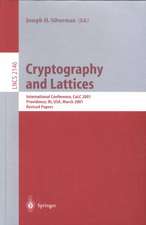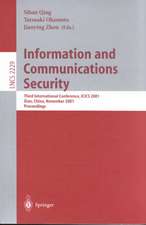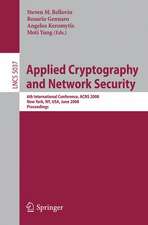CryptoGraphics: Exploiting Graphics Cards For Security: Advances in Information Security, cartea 20
Autor Debra Cook, Angelos D. Keromytisen Limba Engleză Paperback – 29 noi 2010
CryptoGraphics: Exploiting Graphics Cards for Security explores the potential for implementing ciphers within GPUs, and describes the relevance of GPU-based encryption to the security of applications involving remote displays. As the processing power of GPUs increases, research involving the use of GPUs for general purpose computing has arisen. This work extends such research by considering the use of a GPU as a parallel processor for encrypting data. The authors evaluate the operations found in symmetric and asymmetric key ciphers to determine if encryption can be programmed in existing GPUs. A detailed description for a GPU based implementation of AES is provided. The feasibility of GPU-based encryption allows the authors to explore the use of a GPU as a trusted system component. Unencrypted display data can be confined to the GPU to avoid exposing it to any malware running on the operating system.
| Toate formatele și edițiile | Preț | Express |
|---|---|---|
| Paperback (1) | 633.68 lei 6-8 săpt. | |
| Springer Us – 29 noi 2010 | 633.68 lei 6-8 săpt. | |
| Hardback (1) | 639.59 lei 6-8 săpt. | |
| Springer Us – 2 iun 2006 | 639.59 lei 6-8 săpt. |
Din seria Advances in Information Security
- 20%
 Preț: 997.94 lei
Preț: 997.94 lei - 20%
 Preț: 647.28 lei
Preț: 647.28 lei - 20%
 Preț: 901.80 lei
Preț: 901.80 lei - 20%
 Preț: 1165.69 lei
Preț: 1165.69 lei - 20%
 Preț: 866.25 lei
Preț: 866.25 lei - 20%
 Preț: 935.17 lei
Preț: 935.17 lei - 20%
 Preț: 638.69 lei
Preț: 638.69 lei - 15%
 Preț: 637.28 lei
Preț: 637.28 lei - 20%
 Preț: 647.79 lei
Preț: 647.79 lei - 20%
 Preț: 1152.15 lei
Preț: 1152.15 lei - 18%
 Preț: 1004.81 lei
Preț: 1004.81 lei - 20%
 Preț: 545.13 lei
Preț: 545.13 lei - 20%
 Preț: 1050.67 lei
Preț: 1050.67 lei - 18%
 Preț: 1674.82 lei
Preț: 1674.82 lei - 20%
 Preț: 933.57 lei
Preț: 933.57 lei - 20%
 Preț: 1171.94 lei
Preț: 1171.94 lei - 20%
 Preț: 931.50 lei
Preț: 931.50 lei - 18%
 Preț: 949.10 lei
Preț: 949.10 lei - 20%
 Preț: 995.75 lei
Preț: 995.75 lei - 20%
 Preț: 644.66 lei
Preț: 644.66 lei - 20%
 Preț: 643.30 lei
Preț: 643.30 lei - 15%
 Preț: 641.20 lei
Preț: 641.20 lei - 20%
 Preț: 647.61 lei
Preț: 647.61 lei - 20%
 Preț: 648.11 lei
Preț: 648.11 lei - 20%
 Preț: 652.54 lei
Preț: 652.54 lei - 20%
 Preț: 642.98 lei
Preț: 642.98 lei - 20%
 Preț: 640.35 lei
Preț: 640.35 lei - 15%
 Preț: 639.59 lei
Preț: 639.59 lei - 15%
 Preț: 637.46 lei
Preț: 637.46 lei - 20%
 Preț: 820.50 lei
Preț: 820.50 lei - 18%
 Preț: 1219.01 lei
Preț: 1219.01 lei - 15%
 Preț: 634.18 lei
Preț: 634.18 lei
Preț: 633.68 lei
Preț vechi: 745.50 lei
-15% Nou
Puncte Express: 951
Preț estimativ în valută:
121.27€ • 126.45$ • 100.79£
121.27€ • 126.45$ • 100.79£
Carte tipărită la comandă
Livrare economică 20 martie-03 aprilie
Preluare comenzi: 021 569.72.76
Specificații
ISBN-13: 9781441939647
ISBN-10: 1441939644
Pagini: 160
Ilustrații: XVI, 140 p. 20 illus.
Dimensiuni: 155 x 235 x 8 mm
Greutate: 0.23 kg
Ediția:Softcover reprint of hardcover 1st ed. 2006
Editura: Springer Us
Colecția Springer
Seria Advances in Information Security
Locul publicării:New York, NY, United States
ISBN-10: 1441939644
Pagini: 160
Ilustrații: XVI, 140 p. 20 illus.
Dimensiuni: 155 x 235 x 8 mm
Greutate: 0.23 kg
Ediția:Softcover reprint of hardcover 1st ed. 2006
Editura: Springer Us
Colecția Springer
Seria Advances in Information Security
Locul publicării:New York, NY, United States
Public țintă
Professional/practitionerCuprins
Graphical Processing Units.- Motivation.- Encryption in GPUs.- Remotely Keyed Cryptographics.- Related Issues.- Extensions.- Conclusions.
Notă biografică
An invited speaker at the 2005 RSA Conference, Cryptographers’ Track, Debra Cook is a Ph.D. student in computer science at Columbia University in New York. Her research interests are focused in applied cryptography. She has a B.S. and M.S.E. in mathematical sciences from the Johns Hopkins University and an M.S. in computer science from Columbia. After graduating from Johns Hopkins, she was a senior technical staff member at Bell Labs and AT&T Labs before pursuing her Ph.D.
Angelos Keromytis is an Assistant Professor of Computer Science at Columbia University. His research interests include design and analysis of network and cryptographic protocols, software security and reliability, and operating system design. He received his Ph.D. in Computer Science from the University of Pennsylvania, and his B.S. in Computer Science from the University of Crete in Greece.
Angelos Keromytis is an Assistant Professor of Computer Science at Columbia University. His research interests include design and analysis of network and cryptographic protocols, software security and reliability, and operating system design. He received his Ph.D. in Computer Science from the University of Pennsylvania, and his B.S. in Computer Science from the University of Crete in Greece.
Textul de pe ultima copertă
CryptoGraphics: Exploiting Graphics Cards for Security explores the potential for implementing ciphers within graphics processing units (GPUs), and describes the relevance of GPU-based encryption and decryption to the security of applications involving remote displays.
As a result of the increasing processing power of GPUs, research involving the use of GPUs for general purpose computing has arisen. While GPUs do not support the range of operations found in CPUs, their processing power has grown to exceed that of CPUs and their designs are evolving to increase their programmability. GPUs are especially attractive for applications requiring a large quantity of parallel processing. This work extends such research by considering the use of GPUs as a parallel processor for encrypting data.
The authors evaluate the operations found in symmetric and asymmetric key ciphers to determine if encryption can be programmed in existing GPUs. While certain operations make it impossible to implement some ciphers in a GPU, the operations used in most block ciphers, including AES, can be performed in GPUs. A detailed description and code for a GPU based implementation of AES is provided.
The feasibility of GPU-based encryption allows the authors to explore the use of a GPU as a trusted system component. The motivation for using a GPU as a trusted component, including the applicability to thin-client and remote conferencing applications, is discussed. By enabling encryption and decryption in a GPU, unencrypted display data can be confined to the GPU to avoid exposing it to any malware running on the operating system. A prototype implementation of GPU-based decryption for protecting displays exported to untrusted clients is described. Issues and solutions related to fully securing data on untrusted clients, including the protection of user input, are also discussed.
CryptoGraphics: Exploiting Graphics Cards for Securityis designed for a professional audience of researchers and practitioners in industry. This book is also suitable as a secondary text for advanced-level students in computer science.
As a result of the increasing processing power of GPUs, research involving the use of GPUs for general purpose computing has arisen. While GPUs do not support the range of operations found in CPUs, their processing power has grown to exceed that of CPUs and their designs are evolving to increase their programmability. GPUs are especially attractive for applications requiring a large quantity of parallel processing. This work extends such research by considering the use of GPUs as a parallel processor for encrypting data.
The authors evaluate the operations found in symmetric and asymmetric key ciphers to determine if encryption can be programmed in existing GPUs. While certain operations make it impossible to implement some ciphers in a GPU, the operations used in most block ciphers, including AES, can be performed in GPUs. A detailed description and code for a GPU based implementation of AES is provided.
The feasibility of GPU-based encryption allows the authors to explore the use of a GPU as a trusted system component. The motivation for using a GPU as a trusted component, including the applicability to thin-client and remote conferencing applications, is discussed. By enabling encryption and decryption in a GPU, unencrypted display data can be confined to the GPU to avoid exposing it to any malware running on the operating system. A prototype implementation of GPU-based decryption for protecting displays exported to untrusted clients is described. Issues and solutions related to fully securing data on untrusted clients, including the protection of user input, are also discussed.
CryptoGraphics: Exploiting Graphics Cards for Securityis designed for a professional audience of researchers and practitioners in industry. This book is also suitable as a secondary text for advanced-level students in computer science.
Caracteristici
Describes unique approach for disabling spyware Explores the use of a Graphics Processing Unit (GPU) as a trusted system component Provides a detailed description and code for a GPU-based implementation of the AES Highly-regarded in this new research area, Debra Cook was an invited speaker at the 2005 RSA Conference, Cryptographers’ Track Includes supplementary material: sn.pub/extras


























